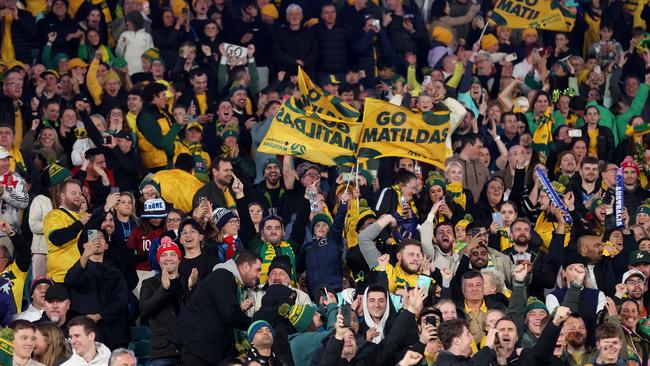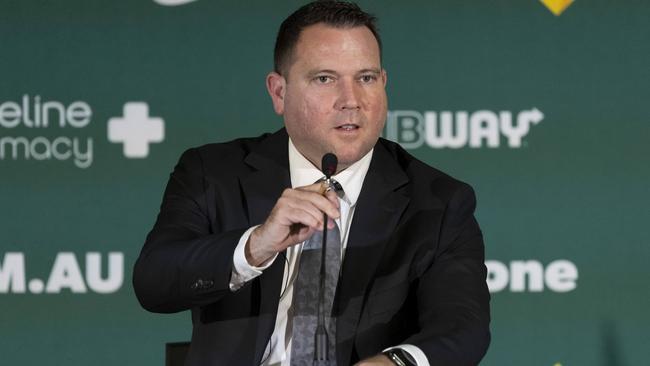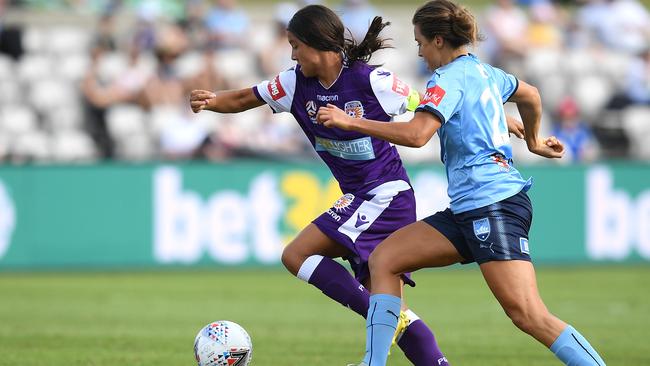Women’s World Cup: How Australia can capitalise on Matildas’ success | Adam Peacock
The Matildas have captivated the country like never before, but what happens next? ADAM PEACOCK reveals the plans to ensure there is no lull for women’s football in Australia.

World Cup
Don't miss out on the headlines from World Cup. Followed categories will be added to My News.
After the best Women’s World Cup ever, now for the easy bit.
Capitalising.
It’s never been a strong suit of Australian football. Socceroos success at the 2006 World Cup came and went. Socceroos success at the 2015 Asian Cup came and went.
Matildas, a nation captivated like never before, what now?
Administrators, over to you.
At both Football Australia and club level, plans are in place to ensure there will be no lull.
FA CEO James Johnson is really clear on how the momentum is carried into the future.
“When we put our best foot forward as a game here in Australia, it’s when we can bring the best global content back to our communities,” Johnson tells CODE Sports.
“That’s how we connect our local game to the global game.”

Making sure the Matildas play on home soil as much as possible is a key objective.
Not easy. It’s a worldwide calendar to fit into, and 19 of the 23 current Matildas squad are based in Europe.
The Matildas are locked in for three Olympic qualifiers, against Iran, Philippines and Chinese Taipei in Perth in October. Assuming that goes well, there is a home and away playoff in February to actually qualify for the Olympics in Paris next July.
Around those fixtures, there are six other international dates between now and November 2024, with at least two matches for each.
Some, to cut down on travel, will be played in Europe, but FA has every intention of getting the Matildas back home.
“The more we can bring them back to Australia, the better,” Johnson tells CODE Sports, adding the team will play on the east coast at least once before the Olympics.
“The players are committed to building the brand, but we have to balance it up with the reality they play around the world, and every flight costs them a day of travel.
“If not (games here), the next best thing is to play in markets and time zones that are good for the Australian audience.”

So that’s step one, putting the Matildas in front of the eyeballs that can’t get enough of them.
But what about the big picture, and, as Frank Lowy once called his start up A League competition, “the shop front product”?
The A League Women’s is run by the organisation that broke away from Football Australia in 2020, the APL, who announced this week the new women’s season would start with a stand-alone weekend in mid-October. Never been done before. And under-16’s will get in free to games.
All part of a growth strategy happening all over the world.
“In worldwide clubs, revenue for women’s teams is about 0.5% to 1% of (overall) revenue,” APL board member Ebru Koksal tells CODE Sports.
“But the believers say this is the fastest growing segment of football, fastest growing women’s sport, ‘I need to be in there’, and they are faithfully investing.”
“The APL and the clubs are on this path.”
Ebru Koksal has broken a few glass ceilings herself in the last two decades.
At the turn of the century, Koksal made the leap from the patriarchy of Wall St finance — “I think there are more Fortune 500 CEO’s named John than there are females!” — she laughs, before her career switched to another male-dominated domain.
Football.
At the turn of the century Koksal joined the board of childhood club, Turkish giants Galatasaray, and has spent 23 years since in various roles with clubs and FIFA, to her present gig on the board of the APL, overseeing the A League women’s.
Koksal can see unlimited potential.
“As APL and also the clubs, it’s on us to portray these wonderful players who are coming from all over the country, passionate about football,” she says.
“It requires many different organisations to come together.”
That includes a close relationship with Football Australia, who appointed Koksal as an independent director to the APL board.
Koksal is solely focused on the APL’s objectives.
The next six months will be the biggest test of how aligned the two organisations are with such an opportunity at stake.
Football Australia, through CEO Johnson, is clear on what the A League Women’s should be.
“We need to think about our local competitions as producers of talent,” Johnson says.
“Things have changed, and they’ve changed in a good way, and our role is to export talent.
“And that’s OK because that should result in people coming to watch the A League Women’s, because you’re going to see the next generation, who will end up playing for the Matildas and the big clubs in the world and that’s quite exciting.
“That’s our role. If we want to be a top football nation – and I think we can say that right now – we want our best players, men’s and women’s in the best leagues, our coaches too, but we need our leagues to be focused on producing export talent.”

With the best players heading overseas for the foreseeable future, the local competitions’ evolution will be a slow burn.
“You look at the example of the Premier League in England,” Koksal says, “from the early 90s when no-one said it would work, it takes two, three decades.”
Koksal points to upcoming A Leagues expansion as a driver of growth. From the current 12 teams, to 14 teams in 2024 and 16 teams in 2025.
“More matches, longer seasons, more playing time,” Koksal says.
It will put further strain on the already limited resources of A Leagues clubs.
No club makes money on its women’s side. Most games run at a loss. One former club executive told CODE Sports his club would spend more on getting an ambulance to a game than ticket revenue received at the gate.
The World Cup looms as the biggest shape-shifter of that narrative.
But in that, one example of a feeling of disconnect explains the hard work ahead.
The APL is keen to get its hands on the data from the 1.8 million ticket sales, but that data is owned by FIFA, and can be accessed by Football Australia.
However, that data isn’t available to the APL, who hope to use it to fully understand how to grow the A League Women’s fanbase.

“Immediately in the next three to six months that attention is well addressed by the clubs as well as by us (APL) to make sure we are able to capture more girls to play and come to stadiums,” Koksal says.
“How do we dissect that and to really know who is interested in women’s football in this country, so we can bring them back to the stadium’s? That is a very important part of the puzzle to us.”
Koksal, more than just about anyone, understands what the success of this tournament will mean to help continue the rapid evolution of women’s football.
“This World Cup has definitely surpassed anyone’s expectations in any aspect. I knew it would break the records, but not by this much,” Koksal says, before looking to the future.
“Each of us has a role to make sure we are investing equitably to that pathway.
“And it’s not just players. If we are lifting participation rates, who is going to coach them, who is going to ref them.”
“It’s one pathway.”
More Coverage
Originally published as Women’s World Cup: How Australia can capitalise on Matildas’ success | Adam Peacock





